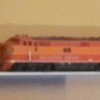From 1946 until mid 1952 Pennsy passenger diesels were delivered in DGLE with five gold stripes. In the summer of 1952 the railroad published instructions for most classes of passenger power to be repainted Tuscan red with immitation gold (dulux) lettering and stripes. From my less than comprehensive photo survey it seems it took about a year for the fleet to be repainted. Since by that time the Centipedes were largely out of passenger service, they never were painted Tuscan. Dual service diesels such as the FM Erie builts and all but two ABA sets of FP7's were single stripe DGLE from delivery to scrapping. Around 1956 the PRR revised the Tuscan red passenger scheme from five stripes to a single wide one with bold lettering. Some BP20's carried the Tuscan five stripe scheme into the 1960's. Later in the 1960's up until Penn Central the PRR repainted a number of E7 and E8 in solid Tuscan without stripes, simply applying large PRR keystones on the sides of the bodies.
A more subtle change related to the keystones on the noses of A units. Initially locomotive numbers were found in the keystone (as with steam locomotives), starting in 1953 the lettering standard was revised to use overlapped PRR letters in the nose keystone, like was the practice with side keystones all along.






